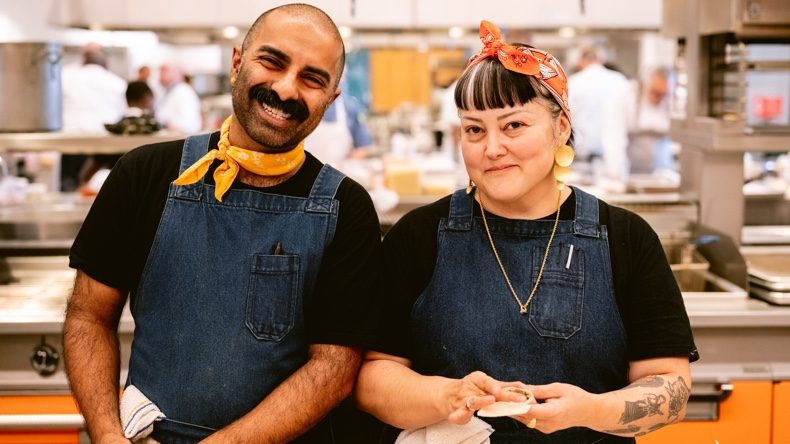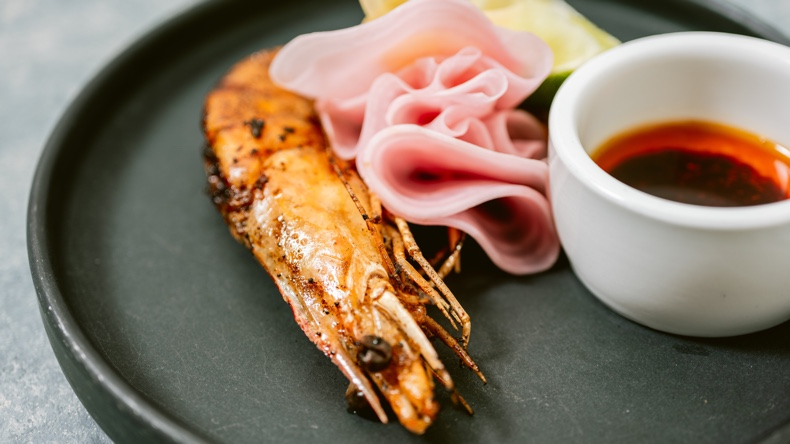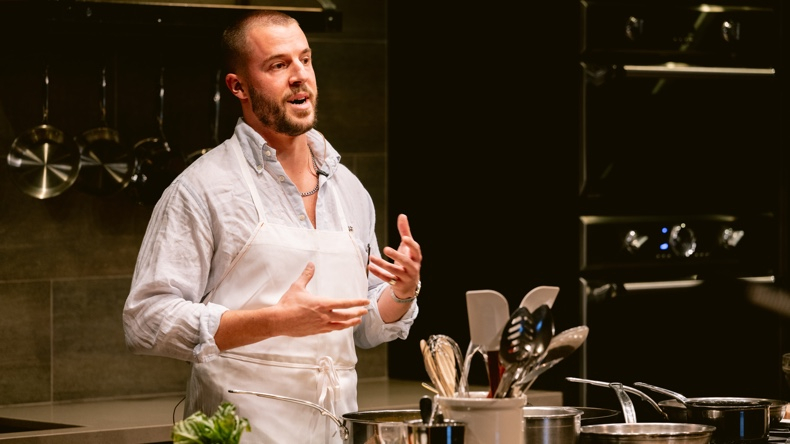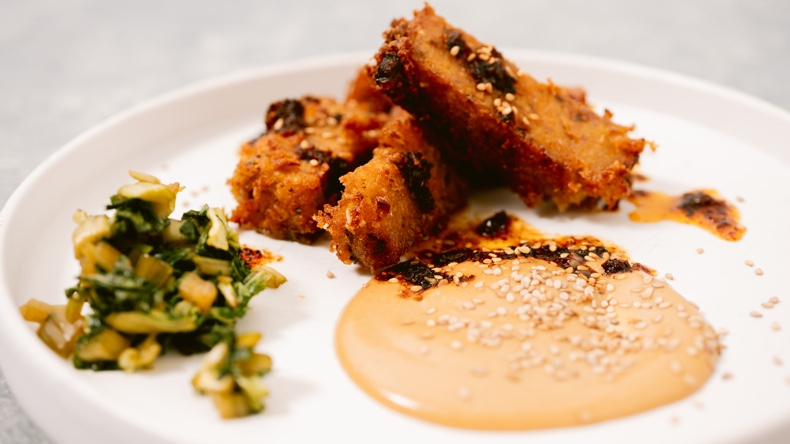Food
Tracing Culinary Traditions and History at This Year’s Worlds of Flavor Conference
“What is tradition?” asked Author Giselle Kennedy Lord as she closed out this year’s 26th annual Worlds of Flavor, themed “Borders, Migration, and the Evolution of Culinary Tradition.” “It’s highly personal, regional, and driven by where you are, who you are, who’s around you, and what grows around you.” The conference, held early November at the CIA at Copia in Napa Valley, featured chefs and presenters from all over the world who traced how dishes have traveled and evolved through the history and evolution of cultures. We heard all sorts of personal stories over the two and half days, and as Lord said: “We also saw a lot of cooking from the heart.”
“How do you connect the natural dots of food? How do we connect with each other?” asked Chef/Consultant Christine Lau during her demo for a shrimp and grits-inspired turnip cake with XO sauce. She starts with an ingredient, flavor profile, or technique, “but don’t push or force it, that’s when you’re not telling that authentic story anymore.” Other stories we heard included London chef/recipe developer Jordon Ezra King’s deep dive into the unexpected origins of spaghetti and tomato sauce, and got to hear the journey of vanilla from Masala Y Maíz’s Norma Listman and Saqib Keval, to name a few.
Telling the (Real) History of Vanilla
“When I say vanilla, what comes to mind?” asked Saqib Keval of Mexico City’s Masala y Maíz during his demo on personalizing traditional cuisine. “Bland? Sweet? Baked goods?” “And what do you think when someone says, oh that person is so vanilla,” asked Norma Listman. “It’s not a compliment,” laughed Keval. The couple (she’s Mexican, he’s of Indian and East African descent) started Masala y Maíz as a research and political project with a focus on the migration of cooking techniques, ingredients, and political movements in South Asia, East Africa, and Mexico; their restaurant opened in 2017. “There are so many similarities between the way our cultures eat, and when Norma and I were getting to know each other and cooking together, we wanted to find out why our foods and techniques were so similar and why we have the same cravings and construction of flavors,” says Keval.

For their demo, they made a river prawn dish that’s the most popular, and political, on their menu. They started their demo by tracing the origins of vanilla, which is indigenous to Mexico, “but we think of it as a European ingredient in pastry that’s bland and sweet and white,” said Keval. “Vanilla started in Mexico and went all over the world through colonization. How do we get from one of the most complex spices—something that’s dark, musty, spicy, and earthy—to something considered only sweet and white and bland?” The couple explained that it was the Totonac tribe, a Middle American Indian population of east-central Mexico who started cultivating vanilla as part of a spiritual practice, until they were conquered by the Aztecs in 1450. When the Aztecs were colonized by the Spaniards in 1521, vanilla was brought to Spain, but without natural propagation from Melipona bees, they couldn’t cultivate the black orchids that produce vanilla outside of Mexico. It was in 1841 that a young slave named Edmund Albius figured out how to artificially propagate vanilla on the island of La Réunion and it was eventually produced all over France and beyond. At Masala Y Maíz, Listman and Keval try to give cultural context to all of their food and want guests to understand its significance on the menu.

Their camarones pa’ palar is a delicious example that starts with ghee infused with vanilla vines and seeds. The river prawns are stuffed with a chile morita (using the vanilla seeds), basted with the ghee and served with thinly sliced pickled beets. “Knowing our food histories is how we can understand the future of our communities, save our communities and build stronger, more resilient communities,” says Keval.
The First Accounts of Spaghetti and Tomato Sauce
“It’s strange to say pasta only arrived in Italy about a thousand years ago with the Arab conquest of Sicily, but it’s true,” said recipe developer/chef/storyteller Jordon Ezra King. He broke down the origins of spaghetti and tomato sauce and presented a risotto-style version of his own. “Some dishes feel so deeply rooted and tied to a place, and it’s easy to imagine they’ve always been there, but they’re actually modern and have come about as the result of migration, and movement of ideas, ingredients, and people that have led to form these traditions,” he said.

Of course, an ingredient is not going to take root in history without the right conditions. King explained that the Sicilian sun was conducive to growing durum wheat, and the waterways allowed for constructing mills to turn wheat into flour for pasta, even if it wasn’t called pasta at that point (the first documented name is itriyya, the old Arabic word for string). He then got into the appearance of tomatoes, which the Spanish first brought to Latin America for the Columbian Exchange during the 1500s, along with potatoes, chiles, and peppers. Tomatoes grew as an ornamental plant for a few hundred years before they finally made their way to Italy.
By the 1700s there are the earliest examples of people eating tomatoes in Campagna. “Naples had become the epicenter of dried pasta production in the country and we’ve got the first evidence of tomatoes being eaten in the same place so up until that point, pasta had never been eaten with tomatoes because they didn’t have them,” he explains. “It's two components from outside Italy but they came together there and became this iconic symbol of Italian cuisine before moving to America in the 1800s,” he said.

King shared his recipe for spaghetti al pomodoro risottata, where he makes by toasting spaghetti in a dry pan for one to two minutes before adding basil and blended tomatoes, stirring as the water boils and starch is released. “The method is similar to cooking risotto,” he says. “It’s cooking in its own sauce so it’s absorbing the tomatoes, garlic, and basil. You end up with a creamy, kind of glossy sauce. It tastes like spaghetti Pomodoro but it’s slightly different, it’s kind of a new way of thinking about the dish.” Get the recipe here.

Connecting the Dots to Get to Shrimp and Grits
At the Birmingham Food + Culture Fest in September, Chef/Consultant Christine Lau was tasked with creating a dish that used Anson Mills yellow grits for 300 guests. When she found out many of the other chefs were doing a version of shrimp and grits, she wanted to take a different approach. “I’m not from the South so I thought, how am I going to make this dish any better than the people down here with restaurants based on it?” she said. “Pulling these dishes out of your back pocket can be hard, so what can help is going back to the land, where are you?”

Following her own advice to connect the food dots, she started with a grains-based ingredient—polenta—a dish she felt comfortable with having cooked Italian food for 10 years. From there she turned to turnip cakes, paying homage to the popular dim sum and Southern ingredient. “It normally has dried shrimp and pork in it and I thought, hey we're hitting shrimp and grits here,” she said. To the grits she added shiitakes and steamed Chinese bacon, raw purple topped turnips (the daikon would traditionally be cooked or steamed but Lau likes the spicy bite of raw) along with salted chopped daikon before setting in a sheet pan and chilling overnight. They are cut into cakes and deep-fried (it’s more traditional to pan-fry but Lau likes the texture of a deep-fry so “those big kernels of grits get crunchy”). For garnish, Lau kept connecting more dots. Daikon or turnip cakes would be served for dim sum with hoisin and chili sauce, so she subbed in sesame sauce and a XO sauce made with dried shrimp, Benton's country ham, chilies, and scallions. She finishes the dish with soy sauce-pickled turnip green tops (collards, Chinese broccoli or mustard greens work as well) for acid and sprinkling of toasted heritage benne seeds for crunch. “I did not create shrimp and grits. I did not create daikon cakes. But I wanted to find parallels and the similarities between the two,” says Lau. “When you run into a wall or the road stops when creating a dish, don’t push, don't force it, that’s when it becomes not good anymore, or you aren’t telling the authentic story. The best way to avoid that is to stick to those three spaces of ingredient, flavor profile, and technique and go back to where it came from.” Get the recipe here.
- Log in or register to post comments
